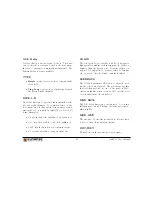
3.2 Oscillators
An oscillator generates a periodic waveform and forms
the basic building block of the majority of synthesiz-
ers (the most common waveforms are illustrated in
fig. 3.2). Antidote offers two banks of oscillators, plus
two sub oscillators. Both oscillator banks allow you to
instantiate between 1 and 24 oscillators with the same
waveform shape, but with a different tuning each. The
sub oscillators are sawtooth and pulse waveforms, and
play one octave below oscillator bank 1 and 2, respec-
tively.
50%
Sawtooth
Pulse
Sine
Triangle
Figure 3.2: Basic oscillator waveforms.
3.2.1 Oscillator 1+2
WAVEFORM and MODIFIER
Each oscillator bank allows you to choose between six
different oscillator types. Each oscillator type has a
unique property which is controlled by the MODIFIER
knob. All other parameters work in the same way, re-
gardless of which type is chosen (Exception: Noise).
•
Sawtooth: A high-quality analog-style sawtooth
oscillator. Each sawtooth in the bank has a vir-
tual master oscillator, which allows to hard sync
the sawtooth to the frequency of the master os-
cillator. When set to zero, the master oscilla-
tor has no effect, resulting in a regular sawtooth
waveform output. As the MODIFIER knob is
increased, however, the master frequency is pro-
gressively lowered relative to the specified pitch,
producing the well-known oscillator sync sound.
•
Digital Saw: A basic sawtooth waveform, fol-
lowed by a highpass filter. The digital sawtooth
oscillator generates a lot of aliasing noise, which
is particularly audible at high frequencies. This
is useful as a creative effect, for instance to syn-
thesize noisy high string notes, as popularized by
older digital gear. The MODIFIER knob adjusts
the frequency of the highpass tracking filter, pro-
gressively increasing its relative frequency. As a
7
Antidote User’s Manual
Содержание Antidot
Страница 1: ...User s Manual...








































